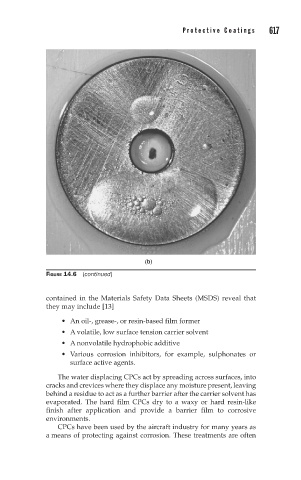Page 663 - Corrosion Engineering Principles and Practice
P. 663
616 C h a p t e r 1 4 P r o t e c t i v e C o a t i n g s 617
(b)
FIGURE 14.6 (continued)
contained in the Materials Safety Data Sheets (MSDS) reveal that
they may include [13]
• An oil-, grease-, or resin-based film former
• A volatile, low surface tension carrier solvent
• A nonvolatile hydrophobic additive
• Various corrosion inhibitors, for example, sulphonates or
surface active agents.
The water displacing CPCs act by spreading across surfaces, into
cracks and crevices where they displace any moisture present, leaving
behind a residue to act as a further barrier after the carrier solvent has
evaporated. The hard film CPCs dry to a waxy or hard resin-like
finish after application and provide a barrier film to corrosive
environments.
CPCs have been used by the aircraft industry for many years as
a means of protecting against corrosion. These treatments are often

